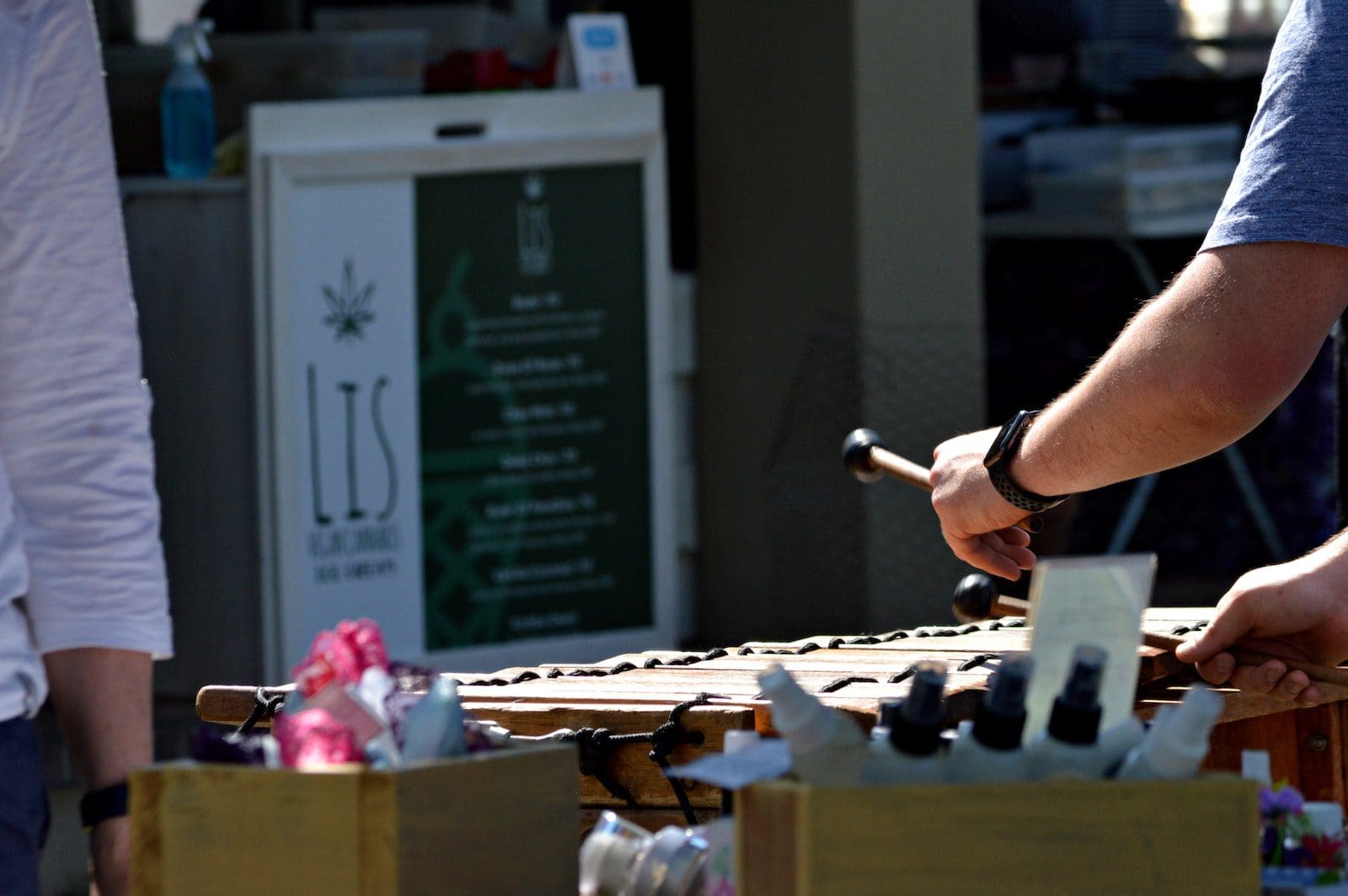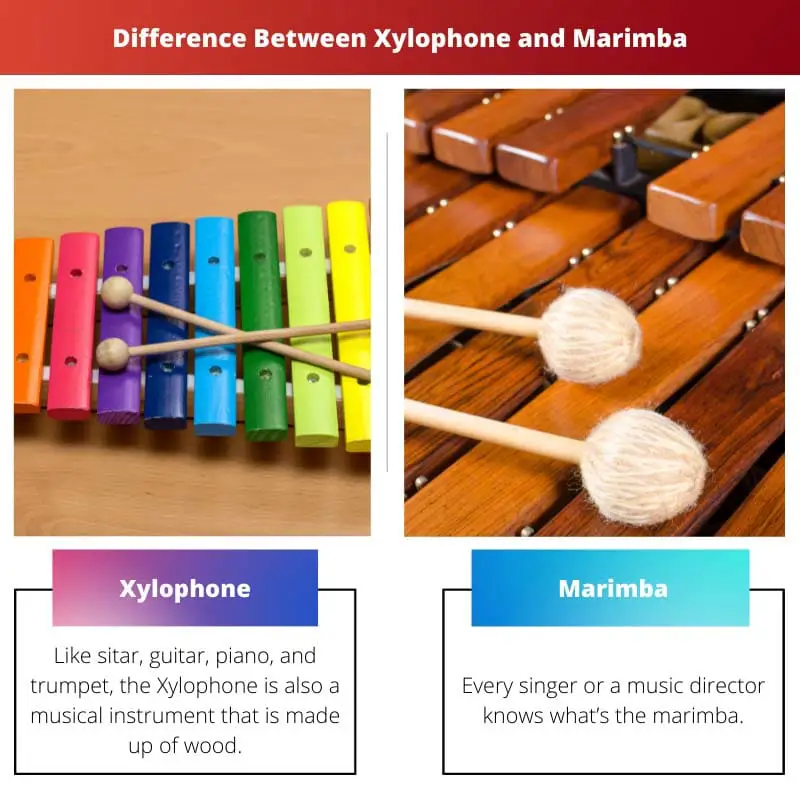Whether it’s a Jazz band or a rock one, people have a soft corner for music. If you’re interested, it’s important to look out for major instruments that make the music melodious.
Xylophone and marimba are also very used musical instruments in the music world. But it’s important to know that they’re not the same.
Key Takeaways
- Xylophone is a percussion instrument made up of wooden bars struck with mallets. At the same time, Marimba is a percussion instrument made up of wooden bars that are struck with mallets and have resonators beneath the bars.
- Xylophone has a bright and high-pitched sound, while Marimba has a warmer and mellow sound.
- Xylophone is used in orchestras and marching bands, while Marimba is used in various musical genres, including jazz, classical, and contemporary music.
Xylophone vs Marimba
Xylophone is a musical tool which musicians use, it produces sound with its wooden bars anchored on a stand and felt. Small Wooden hammers are used to strike the bars to make music. A marimba is a percussion instrument consisting of a set of wooden bars struck with mallets to produce musical tones.

The xylophone means the sound of wood. A xylophone is a musical instrument that is made from wood. It has a set of tuned keys that are arranged as a piano. Every bar of the xylophone is tuned in such a way that it creates sound when a mallet hits it.
On the other hand, Marimba is an instrument with wooden bars stuck with rubber or yarn mallets that produce sounds when they are hit. Also, the chromatic bars are placed in order, just like a piano looks. The person who plays the marimba is known as a marimbist or marimba player.
Comparison Table
| Parameters of Comparison | Xylophone | Marimba |
|---|---|---|
| Octave range | 2-1/2 to 4 is the octave range of xylophones | The octave range of marimba is 3-5. |
| Composition | Xylophone can be made with either rosewood or any other Synthetic material. | Marimba can also be made by Rosewood and synthetic materials, but it can also be made by Paduk wood. |
| Mallet | The mallet of the xylophone is made of rubber to produce sounds when hitting the instrument. | The mallets of the marimba are made either of yarn or cord to produce sounds when hitting Marimba. |
| Resonators | The xylophone has a shorter resonator. | The marimba has longer resonators. |
| Usage | The xylophone is majorly used in concerts, bands, and symphonies. | The marimba is predominantly used in small gatherings, small ensemble. |
What is Xylophone?
Like sitar, guitar, piano, and trumpet, the Xylophone is also a musical instrument that is made up of wood. The literal meaning of the xylophone is “the sound of wood”.
Because it’s made up of trees, it’s adjusted in such a way that it makes noises when a mallet hits it. Mallet is a hammer-like structure that is used to play the Xylophone.
The xylophone also includes instruments that require mallets or other items to make lovely noises. It could be a marimba, Balaton, or a semantron as well.
The xylophone is such a musical instrument that it’s like a narrow table whose face is divided into several blocks. It seems like a piano with the same keys as the wood planted onto the instrument.
The keys are tuned so that they make noises when hit by a mallet. The trees involved In making a xylophone are redwood trees or by any other Synthetic substance.
The mallets are also made in such a way that it produces sound without destroying the instrument. The mallets are made of rubber, which makes them good for Xylophone.
Majorly, xylophones are used in several big events and gatherings, like in concerts, with the orchestra, or any other big function. It’s widely used to produce sounds for songs and act as a background link. A xylophone is one of a kind instrument and a very important part of the musical world.

What is Marimba?
Every singer or music director knows what’s the marimba. Well, the popularity of marimba is great since it makes several beautiful tones that will soothe your mind and body.
Well, the marimba is a musical instrument that is used to produce musical tones. It’s made up of wooden bars when hit by the mallets.
Marimba is extracted from specific trees to make a good and robust marimba. It’s taken from rosewood trees, or maybe a synthetic substance can be used.
Another type of tree used to make a marimba is Paduk wood. Also, the mallets are made from yarn or rubber mallets to maintain the noise without destroying the device.
The octave range of a marimba is 3-5, where five is widely appreciated across the world. The bars of a Marimba are chromatic and arranged like the keys of a piano.
There are resonators, or we can say pipes, that are installed below the bars from where the sound is amplified. Also, the resonators installed in a marimba are longer ones.
Marimba is predominantly used in many small and private gatherings where there’s not much crowd.
Also, some modern uses of marimba can be for solo performances, woodwind and brass ensemble, marimba-specific concerts, jazz bands, marching bands, indoor percussion ensembles, or orchestral compositions.

Main Differences Between Xylophone and Marimba
- The octave range of a xylophone is around 2-1/2 to 4, while the octave range of a marimba is from 3-5, where 5 is preferred.
- A xylophone’s resonators are smaller, while the resonators of a marimba are longer.
- Rosewood trees and synthetic substances are used to make perfect xylophones, but Paduk wood is used to make a marimba apart from these.
- The mallets of the xylophone are made of only rubber, while the mallets of a marimba could be of either rubber or yarn.
- Xylophones are widely used in huge gatherings or concerts of big events, while marimba is used in smaller gatherings, solo performances, etc.

- https://books.google.com/books?hl=en&lr=&id=lc4UAAAAIAAJ&oi=fnd&pg=PA1&dq=Xylophone&ots=6e0hFsWKm4&sig=8Xu6BaKHIGnecqGtxi6Hc2dML3U
- https://journals.sagepub.com/doi/abs/10.1177/0305735608094511